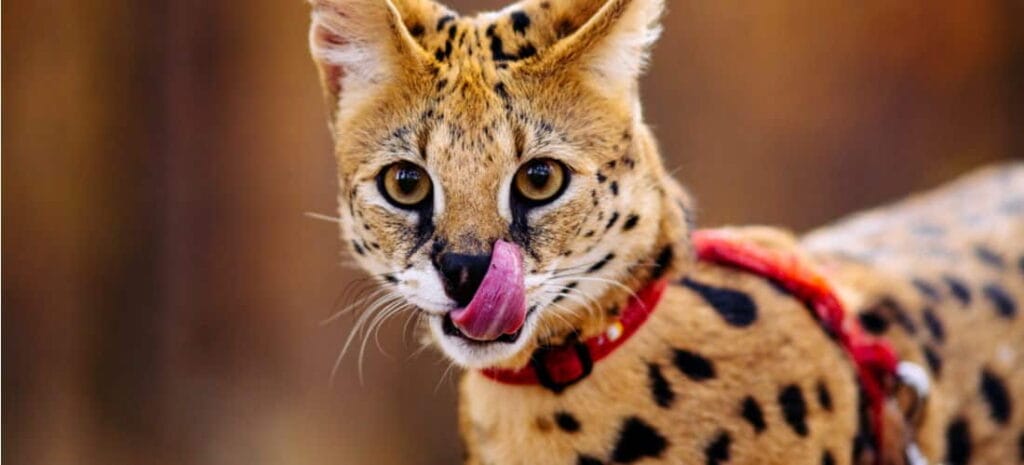Characteristics, History, Care Tips, and Helpful Information for Pet Owners
Several people keep beautiful serval cat as exotic pets. Despite being available from breeders, serval cats are still thought of as wild animals. You need to construct a substantial, secure outside cage and provide a warm environment all year round in order to maintain a serval cat as a pet. They will require medical care from an experienced exotics veterinarian as well as the consumption of whole prey animals.
Understanding the risks associated with raising wild animals is essential. A lot of places forbid owning serval cats, while other places demand licenses, permits, and inspections. Consult your local laws to learn which will be applicable. If you are unable to care for them, finding a new home for feral cats may be difficult.

Breed Overview
- WEIGHT: 20 to 40 pounds
- LENGTH: 2 feet
- COAT: Short
- COAT COLOR: Golden yellow to buff with black spots and stripes
- EYE COLOR: Brownish to greenish
- LIFE EXPECTANCY: Up to 22 years in captivity
Characteristics of the Serval Cat
| Affection Level | Medium |
| Friendliness | Low |
| Kid-Friendly | Low |
| Pet-Friendly | Low |
| Exercise Needs | High |
| Playfulness | High |
| Energy Level | High |
| Intelligence | High |
| Tendency to Vocalize | Medium |
| Amount of Shedding | Low |
The Past of the Serval Cat
In order to sneak up on its prey, the serval cat, an animal native to Africa, can blend in with the tall grass and bushes. Although their shorter tails set them apart from cheetahs, they are known to resemble those cats. They typically hunt in secret locations adjacent to bodies of water. They have a home range of roughly 7 kilometers and live alone in the wild. African serval cats are not listed as endangered species.
Servals have the longest legs of any cat, making them superb diggers and quick jumpers (relative to their bodies). They are able to catch birds that are higher than five feet in the air and can burrow through the ground to get their prey.
Growling, spitting, purring, a high-pitched cry used to call other servals, and other vocalizations are all common among servals.
People have had serval cats since the time of the ancient Egyptians, and they are shown in their art. However, they are not tamed. Breeding stock arrived in the country more than a century ago, therefore serval cats that are several generations removed from imports from Africa may be found. Even for such tamed servals, there are restrictions on the possession of wild cats and exotic animals.
Breeders have also combined serval cats with domestic cats to produce hybrid cats like the Savannah cat. A Savannah would be a better choice than a serval if you like the way they look but need a cat that is calmer and simpler to care for.

Serval offers cat care
Since they normally wander at least seven kilometers per day in the wild, these lone, active cats must live in large outdoor habitats. Due to their nocturnal nature, they are more active at night and have been known to hop over or dig under fences. An outdoor enclosure must be completely enclosed on all sides with a top and the sides must extend several feet into the ground; a basic dog run will not do. A pool of water is also important for drinking, swimming, and potentially even letting your serval cat catch its own fish.
Serval cats are known to develop close relationships with humans, particularly if they are bottle- and hand-fed as kittens. Usually, they develop a lifelong bond with just one human. You’ll need to play on the cat’s level and face to face for a while. Although they are often friendly, educating them requires patience and a soft approach. You can try to socialize servals, but they often remain distrustful of outsiders and may grow frightened by visitors.
These cats typically generally reserved during the day and very active at night. If you bring a serval inside, it should be in a room created to keep cats away from breakables, cables, and other hazards because servals may be highly energetic when playing.
Servals instinctively mark their territory by urinating on objects, while they can be trained to refrain from doing so. When walking servals, you will need a unique serval harness because they are not made like domestic cats.
You must have a plan for who will look after your serval cat in case you go on vacation, need a break, or encounter health problems of your own.
Simple health problems
Make sure you have access to a veterinarian with experience caring for exotic animals. Servals must have the same annual vaccinations and dewormings as indoor cats.
Many pet servals are declawed in an effort to keep people safe, although doing so poses the danger of infection. Additionally, it makes the serval helpless in an animal confrontation. Servals frequently have medical crises because they eat foreign things that can lodge in their throats or be difficult for them to pass.
Food intake and diet
Servals make it difficult to mimic their optimum natural diet since they eat whatever is available in the environment. Despite the fact that you may not have access to all of Africa’s wild serval species, the continent’s varied protein sources typically include mice, rabbits, birds, fish, insects, reptiles, and frogs. Whole prey should be offered, but do not be alarmed if your serval consumes it too quickly and develops a blocked throat. It might try to eat the dish again if fermentation from the stomach acid hasn’t already started. They typically play with their food before they eat.
Servals rely less on their sense of smell and more on their senses of hearing and sight to find food.
Servals are exceptionally intelligent cats. The cat will find eating more enjoyable and count as an enrichment activity if there is a game or puzzle that makes them solve issues.
Additionally, add a feline supplement to the meal, ideally one made for servals. It is acceptable to add a pelleted diet to its food as a supplement, but meals shouldn’t be mostly made of it.
Where to Find a Serval Cat for Sale or Adoption
Whether grown in captivity or taken from the wild, these creatures are wild by nature and require a skilled, responsible owner who can meet their very specialized demands.
In 16 states across the union, owning servals is legal. You don’t need a license to own a serval in Wisconsin, North Carolina, Alabama, Nevada, or North Carolina. You can apply for a license to own a serval in Texas, Mississippi, Missouri, Oklahoma, Indiana, Pennsylvania, Rhode Island, Maine, Montana, Idaho, North Dakota, and South Dakota. In every other state, servals are not allowed to be owned.
Contact the Feline Conservation Foundation to find out more if owning a serval is legal in your area and you’re looking for a reputable place to adopt or buy a serval.
Breeds of Cats Not Listed Here and More Research
To gain a deeper understanding of the breed, consult with other serval cat owners, reputable breeders, and exotic cat rescue organizations. Make sure you are familiar with any local laws that may apply to this breed.
If you’re researching similar cat breeds, take into account the advantages and disadvantages of the following:
- Bengal cat, Egyptian Mau Toyger cat
Otherwise, learn more about the available cat breeds.
READ NEXT: Should You Keep a Big Cat as a Pet?

